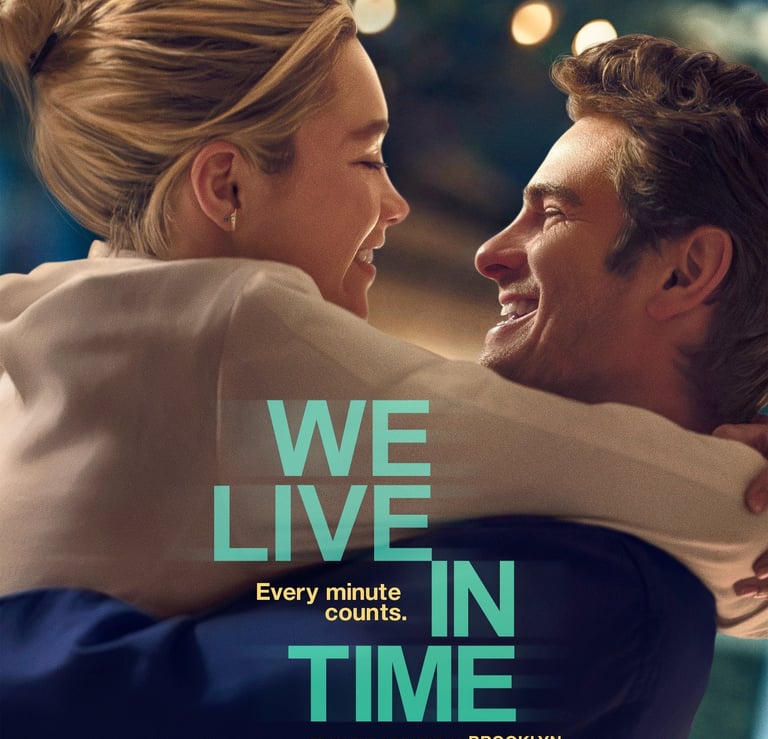
We Live in Time
Life doesn’t stop, even when time is running out.


We Live in Time is a film that initially grabbed attention through its strong casting choices, and the trailer (despite revealing a little too much of the plot) successfully sets the tone for a compelling mix of romantic comedy and drama. The film strikes a delicate balance between light-hearted moments and the emotional weight of dealing with a terminal illness, doing so with sensitivity and grace.
The standout aspect of the film is undoubtedly its cast. Andrew Garfield, playing Tobias, brings a warmth and charm to the role. His portrayal of a man grappling with the difficult emotions of caring for a partner with cancer is convincing and empathetic. Garfield manages to capture the complexity of a relative's experience - his love, anxiety, and sense of helplessness in the face of his partner’s illness. The performance is tender and heartbreaking, particularly in moments where his character’s internal turmoil is laid bare. Florence Pugh, as Almut, is equally impressive. She handles the film’s wide emotional range with ease, gracefully navigating both the lighter, romantic moments and the more challenging, gut-wrenching aspects of her character’s cancer diagnosis. Pugh portrays Almut as strong, resilient, and deeply human, never shying away from showing the harsher sides of someone living with terminal illness. This depth adds to the film’s authenticity, as it avoids reducing her to just a tragic figure defined solely by her illness. In addition, Grace Delaney, who plays Ella, deserves special mention. Despite her youth, Delaney excels in portraying the weight of complex emotions, understanding the nuances of grief, fear, and love. She provides a natural, grounded presence in each of her scenes, balancing the emotional intensity of the adults around her with an innocence that doesn’t diminish the film’s poignancy.
The film’s script, written by Nick Payne, is a major strength. One of its most significant achievements is how it focuses on the woman at the centre of the story, Almut, as a whole person. Rather than simply becoming defined by her cancer diagnosis, Almut’s character is portrayed as someone who has lived a full and rich life, full of success, relationships, and personal growth. The diagnosis is just one part of her story, not the entirety of it. This is in contrast to many other films in the cancer genre, where the illness often overshadows the character’s identity. The title We Live in Time encapsulates the film’s core theme: time is precious, and while a diagnosis may signal an end, it also emphasises that there is still time left, time to love, to experience joy, and to make meaningful memories. The film ultimately conveys a message of hope, even in the face of terminal illness. Almut is not portrayed as a perfect character throughout the film. She can be selfish, brash, and difficult at times. However, these aspects of her character are believable and add to the film’s authenticity. This is a person living with a terminal illness, and it is clear that the disease can sometimes bring out sides of her personality that are hard to watch. Yet, these moments are a reflection of the strain and emotional upheaval that a terminal diagnosis can bring. Similarly, Tobias, while loving and caring, is shown as anxious and somewhat overprotective. At times, his actions may even come across as irritating, but this is also a realistic portrayal of the emotional toll that caring for a sick partner can have. His nervousness, his attempts to balance love with fear, are human traits that many viewers will find relatable.
The film’s non-chronological storytelling is a stylistic choice that adds an extra layer of complexity. The decision to present the narrative in this fragmented way is intriguing, though its purpose may not always be entirely clear. The structure draws attention to the parallel timelines of Tobias and Almut’s relationship, one from the beginning of their love story, and one from its later, more emotionally challenging moments as they confront her illness. The fractured timeline highlights the passage of time, the way relationships evolve, and how moments of joy and sorrow are inextricably linked. However, it would be interesting to watch the film in chronological order to fully assess the impact of this choice. While the non-linear approach adds a sense of tension and emotional layering, it could also be interesting to see if the story would have had the same effect without this structure. The film’s emotional impact would likely vary depending on the viewer’s own experiences, but the most poignant moments don’t always come from the typical 'cancer movie' fare, the intense medical scenes or moments of grief. Instead, it’s the joyful milestones of Tobias and Almut’s life together that stand out. Their engagement, the discovery that they’re expecting a child, and the birth of their baby, these scenes, filled with love and hope, are what truly resonate. What makes these moments so emotionally charged is the bittersweet awareness of the non-linear timeline and the shadow of Almut’s illness. Knowing that time is running out makes these moments of happiness all the more precious, heightening their emotional impact. This focus on the simple, life-affirming aspects of their relationship sets the film apart from other cancer dramas, which often focus more heavily on the tragedy of the diagnosis.
Despite the heavy subject matter, We Live in Time is infused with moments of British humour, especially in the performances of Pugh and Garfield. The comedic scenes offer relief from the emotional intensity of the story, with one of the most memorable moments being the hilarious birth scene in a petrol station. These moments of levity serve as a reminder of the film’s balance between joy and sorrow, and they provide much-needed lightness amid the film's more emotionally taxing moments. It’s interesting to consider how We Live in Time might have been received in the US, especially given its distinctly British sensibility. The film’s dry wit, subtle humour, and understated emotional moments are very much in line with British filmmaking, and this might have influenced its reception in different cultural contexts.
Ultimately, We Live in Time stands out within its genre due to its focus on the person living with the illness, rather than the illness itself. It presents a hopeful, uplifting story about love, time, and the things that truly matter, even in the face of terminal illness. With great performances, excellent writing, and a fresh perspective on a familiar genre, it is a film that offers both heartache and warmth in equal measure.
